[From Greg: Among much else, this is a killer guide to how to promote a concert in our new age, how to develop an audience. The old ways, as Lara notes, don’t work in new situations. So we have to do something new. She does it!
[I’ll add that I saw Chris O’Riley play the DC-area show on the tour Lara describes, and I loved it. He played his new Liszt album, and took Liszt where he belongs, way over the top. Most pianists tame Liszt, consciously or not. But not Chris! And, though he didn’t say this publicly, he out-Liszts Liszt in his version of Liszt’s transcription of the Symphonie Fantastique, because he adds in orchestral details from the original that Liszt left out. Thus making a wildly difficult piece even harder.]
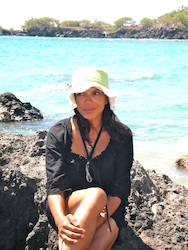
Last month we had quite a wonderful night at The Artist Sessions, and I told Greg I wanted to write about it here, and then I got busy… and then I went on vacation. (VACATION!!)
But now I’m back home, and will take some time, confined to quarters during this 110 degree heat wave in California, to write down my thoughts about everything that went right at The Artist Sessions.
The Sessions had launched in April with a release party for my new album Exiles’ Cafe. It was a grand adventure and a great success. You can read about my experiences here, and here’s a review. Really, I’d done good. So, according to the code of the over-achieving perfectionist, of course I had to do even better the next time.
My next guest artist was Christopher O’Riley, a dear friend and admired colleague both within the piano festival/concert circuit and through our mutual involvement in the world of arts education and mentorship, which has brought us together in collaborations between Chris’ NPR show From the Top and my Young Artists program at the Mondavi Center.
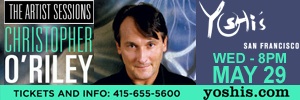 I think Chris is, in many ways, the embodiment of change in the classical music world, through his own genre-bending approach to performance and recording – projects like his chart-sweeping album of Radiohead songs — and through his mentorship of thirteen years worth of brilliant young musicians who are coming up to do great things. Chris was traveling around the country to promote his extraordinary new album O’Riley’s Liszt, and The Artist Sessions was going to be his final and only West Coast tour stop. He was getting terrific reviews (Musical Toronto called his performance “sometimes overwhelming, always awe-inspiring”) and friends were reporting back great things from every show.
I think Chris is, in many ways, the embodiment of change in the classical music world, through his own genre-bending approach to performance and recording – projects like his chart-sweeping album of Radiohead songs — and through his mentorship of thirteen years worth of brilliant young musicians who are coming up to do great things. Chris was traveling around the country to promote his extraordinary new album O’Riley’s Liszt, and The Artist Sessions was going to be his final and only West Coast tour stop. He was getting terrific reviews (Musical Toronto called his performance “sometimes overwhelming, always awe-inspiring”) and friends were reporting back great things from every show.
Have I mentioned that I’m an over-achieving perfectionist? I wanted Chris’ visit to the Sessions to be really special. And I found myself returning to the idea of community, an idea that I’ve written about before in this space. Chris has a strong community, many fans and also many friends. He plays several important, disinct roles in the music world, and in each of those roles he builds important relationships. What I wanted to create for him was an audience that represented that range, a perfect audience for the Sessions, where the goal is for our audience to experience and appreciate the full range of an artist.
So my job, I could see, was to make sure that I was connecting with this whole lovely range of people who care about Chris O’Riley, the artist and the man.
What that meant:
- Classical pianophiles (who’ve been following Chris’ career since his competition wins in the early ’80s)
- Radiohead fans (who discovered and adopted Chris with the breakout success of his Radiohead-transcriptions album)
- From the Top alums and their families (many, many of whom come out of the Bay Area or the San Francisco Conservatory)
- San Francisco Girls Chorus members (who performed last year with Chris an arrangement he wrote for them of Joni Mitchell’s Songs to a Seagull)
That gave me four conversations, and four building blocks for a diversified, engaged audience. So I got online and on the phone (again).
And again, I started with my friends and family – ongoing updates and reminders to my own core audience, especially everyone who had come out to the first Artist Sessions show in April. There’s a fine line between persistence and harassment, and I’ve tried to walk it, while still being open and honest about the fact that the Sessions are new in town, and that we need a little help from our friends! And so far my friends are still answering my calls. Because of that honesty, because, I think, they trust my vision and missions, and because we’d all had a great time together the first time around!
On top of the individual contact, I launched a fairly relentless social media effort, with daily Facebook and Twitter updates on Chris’ breaking album reviews, radio appearances, etc. Chris is an active presence on Facebook too, and we were able to do a lot of sharing among our networks.
This was a lot of work. It just is a lot of work. One of the readers of my first post about the Sessions here on Greg’s blog wrote in with a thoughtful comment about the time-intensive nature of my efforts. They really have been both time and energy-intensive, but I think that’s the only way to build something new. My hope is that word of mouth will grow, and that a self-generating audience will emerge, but what I am seeing right now, early on, is how much the success of this adventure relies on doing more and doing it differently.
That was absolutely crystal clear as we worked up towards Chris’ shows. Because at some of his earlier stops on this tour, unfortunately, audiences were smaller than they should have been. I thought I probably knew what the problem was, and I thought I knew how to address it. We who are out here on what I like to call the “new frontier” in music — who are trying to bring classical music to new audiences and into new spaces — are running into one central problem. When you step outside of the concert hall, you lose the audience that is already there looking for classical music (in the obvious place: a concert hall). Now you’re trying to make a new audience of people who are not necessarily looking for classical music (in a concert hall), but who might be interested in finding it somewhere else (like a club).
And if you want those people to find the music, you have to find them. On the one hand, there can be a wonderful spontaneity and serendipity in building unexpected audiences for unexpected spaces, but I think that you have to build on a solid foundation, and then move upwards and outwards from there. Otherwise you can, unexpectedly, make music in an empty room. This has happened to me. It’s happened to all of us who are braving the new frontier, and it’s so disheartening when it does. It can make a pioneer want to take the first wagon back home, new territory be damned.
So I knew there were some extra miles to go, extra work to do just to build a good audience for this event. And beyond that, there were some special, Chris-specific measures I wanted to take as well. At the Sessions, my goal is to present an in-depth, multi-faceted portrait of an artist, and Chris is the ideal example of a prismatically faceted artist — pianist, composer, media personality, mentor — and I’d realized that I had a lovely opportunity to highlight that versatility, as well as his latest accomplishment, by putting our mutual musical families into action.
I got in touch with the producers at From the Top, and they helped me put together a list of FtT alums who are Bay Area based, most of whom I’ve worked with through my Young Artists program. Then I sent out this email:
Subject: URGENT: SURPRISE From the Top alum mash-up for Chris O’Riley, at Yoshi’s on Wednesday
I am looking for From the Top alums to perform in a short FtT reunion set, as a surprise for Chris when he comes to The Artist Sessions this Wednesday night, May 29. http://www.yoshis.com/sanfrancisco/livemusic/artist/show/3251
Could you please let me know ASAP if you are in town, free on Wednesday the 29th, and avail/interested in performing? I’m looking for very short, fun pieces, especially anything a little outside of standard rep, genre-mixing, etc. Probably will want to put together some ensemble things if we have enough players.
Of course they all wanted to play. Some of these kids are away at college now and had just gotten home from Curtis and New England Conservatory for the summer break. They’ve known Chris since they were little, and they love him and look up to him, and they were so happy to be able to celebrate him! It was a military operation, organizing their performances, sneaking them into the club, hiding them in the kitchen while Chris was in lockdown backstage, choreographing everything so that it could happen. But it was so worth it.
Here’s what happened that night at The Artist Sessions: 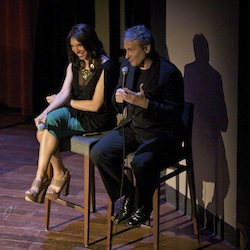
- We showed a video of Chris’ performance with San Francisco Girls Chorus last year.
- Chris and I did a pre-concert conversation. You can listen to an excerpt here.
- Chris played really beautifully. There were a lot of people there. Probably a good 75% of repeat customers from the inaugural Artist Sessions audience (which is amazing!), and a really nice showing of young music students, and, I think, some Radiohead fans. (Just guessing, from the haircuts…) They all loved it. You can watch the concert here.
- Standing ovation! After 45-minute performance of the Berlioz/Liszt Symphonie Fantastique, Chris was drenched. I brought him a beer onstage during his bows!
- Then THIS SURPRISE FROM-THE TOP MASH UP HAPPENED!! I’m watching this video of the kids’ performance now, and it’s making me happy all over again. Look at everyone’s faces, and listen to what the kids had to say to Chris. And listen to how they play!
It was an amazing surprise. It was family. It was community. It was the reason I do what I do, and Chris does what he does, and these young musicians do what they do. Because when we pull together, when we let our lives, our stories and our music intersect, it’s magic.
It has been pointed out to me that overachieving perfectionists have a self-destructive streak. Probably true — outdoing yourself every time can get a person in trouble. We have a whole wonderful season of ten shows coming up next season on The Artist Sessions, starting with Gabriel Kahane, on September 17. I’ll try to keep things normal. But really, a little magic doesn’t hurt.

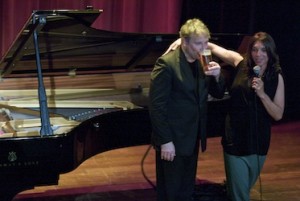
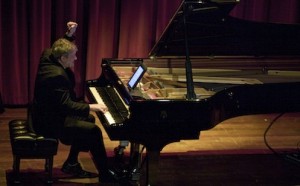
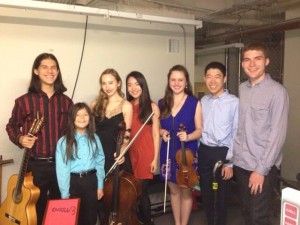
This article by Ms. Downes is excellent–thanks to Greg Sandow for a blog that challenges all of us to keep shaping an intended future for classical music.
LSU’s James M. Syler Distinguished Visiting Artist (2010-13) Christopher O’Riley is featured in this article. http://www.lsu.edu/departments/gold/2013/03/oriley.shtml
Those in the profession of artistic expression need to be vigilent to public school arts funding. Stay close to your state legislatures. K-12 arts education is how audience is built and arts tourism is maintained.
Thanks Ginny, and absolutely in agreement on this! Much of the challenge in building new audiences for classical music now is tied to the loss of arts in schools, the lack of contact that current generations experienced as children. My colleagues and I are doing everything we can to address that on a grass-roots level, often designing our own K-12 programming and working directly with teachers and school administrators to implement them. I’m also the director of UC ArtsBridge, a school/university partnership that brings arts programming into K-12: http://www.artsbridgeamerica.com/home.php. The public funding gap is a big one to fill, but we are trying.
Lara, to be fair, this happens to the not-so-pioneering and local non-classical bands too. Because of the nature of some of the many groups I play with I’ve had the pleasure of playing hundreds of shows with local rock and pop bands in various cities, and just as often as not, we’ll be playing to practically empty rooms as well as packed standing room only shows. There’s nothing inherently more difficult (or less difficult) with pioneering classical acts being able to fill a room or not and many times the performer or promoter has little control over various factors which can contribute to a low turnout.
Most local bands will never play to a big audience, and there’s nothing wrong with that. They are content with just having their friends and some family members at the show and don’t have particular aspirations for becoming big ‘rock stars.’
It’s nice to have a big audience, but sometimes the most memorable show experiences can come from a small but appreciative crowd. Of course, not being able to build a bigger following doesn’t help to sustain a performing career of any sort, but non-classical musicians are just as likely to not fill a room as classical musicians.
Good luck with the rest of your Artist Sessions–sounds like a fun series and I wish I were living closer to it so that I could pop in for a show!
I hear you – thanks for sharing. And I’ve had wonderful experiences with small audiences too, on a very personal level. But, on a more prosaic level, the finances of a series like the Artist Sessions depend on ticket sales, as well as artistic excellence, so my audience development efforts must be ongoing!
Keep us in mind and please stop by if you’re ever in SF!